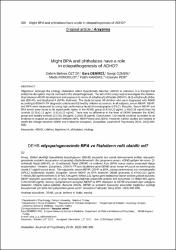| dc.contributor.author | Öztop, Didem Behice | |
| dc.contributor.author | Demirci, Esra | |
| dc.contributor.author | Özmen, Sevgi | |
| dc.contributor.author | Kondolot, Meda | |
| dc.contributor.author | Kardaş, Fatih | |
| dc.contributor.author | Per, Hüseyin | |
| dc.date.accessioned | 2023-12-06T19:31:09Z | |
| dc.date.available | 2023-12-06T19:31:09Z | |
| dc.date.issued | 2018 | en_US |
| dc.identifier.issn | 1302-6631 | |
| dc.identifier.uri | https://hdl.handle.net/11363/6613 | |
| dc.description.abstract | Objective: Although the etiology ofattention deficit hyperactivity disorder (ADHD) is unknown, it is thought that
endocrine disruptors may be involved in the etiopathogenesis. The aim of this study was to investigate the relationship between ADHD development and exposure to mono-(2-ethylhexyl) phthalate (MEHP), di-(2-ethylhexyl) phthalate (DEHP), and bisphenol A (BPA). Methods: The study included 44 children who were diagnosed with ADHD
according to DSM IV-TR diagnostic criteria and 51 healthy children as controls. In all subjects, serum MEHP, DEHP,
and BPA were measured by using high performance liquid chromatography (HPLC). Results: Serum MEHP and
BPA levels were found to be significantly higher in the ADHD group (0.47±0.22 µg/ml, 1.48±0.28 ng/ml) than the
controls (0.31±0.13 µg/ml, 0.91±0.23 ng/ml). There was no difference in the level of DEHP between the ADHD
group and healthy controls (2.17±0.69 µg/ml, 2.26±0.56 µg/ml). Conclusion: Our results could be accepted as an
evidence to support an association between BPA, MEHPlevels and ADHD. However, further studies are needed to
clarify the linkage between ADHD and endocrine disruptors. | en_US |
| dc.description.abstract | Amaç: Dikkat eksikliği hiperaktivite bozukluğunun (DEHB) etiyolojisi tam olarak bilinmemekle birlikte, etiyopatogenezinde endokrin bozucuların rol oynadığı düşünülmektedir. Bu çalışmanın amacı, ADHD gelişimi ile mono- (2-
etilheksil) fitalat (MEHP), di- (2-etilheksil) fitalat (DEHP) ve bisfenol A'ya (BPA) maruz kalma arasındaki ilişkiyi
araştırmaktır. Yöntem: Çalışmaya, DSM-IV-TR tanı ölçütlerine göre DEHB tanısı konan 44 çocuk ve kontrol grubu
olarak 51 sağlıklı çocuk alındı. Tüm olgularda, serum MEHP, DEHP ve BPA, yüksek performanslı sıvı kromatografisi
(HPLC) kullanılarak ölçüldü. Bulgular: Serum MEHP ve BPA düzeyleri DEHB grubunda (0.474±0.223 µg/ml,
1.485±0.285 ng/ml) kontrole (0.311±0.134 µg/ml, 906±0.232 ng/ml) göre istatistiksel olarak anlamlı yüksek bulundu.
DEHP düzeyleri açısından her iki grup karşılaştırıldığında aralarında anlamlı fark bulunmadı (2.168±0.694 µg/ml,
2.262±0.565 µg/ml). Sonuç: Çalışmamızın sonuçları MEHP ve BPA düzeyleri ile DEHB arasındaki ilişki olduğunu
destekler nitelikte kabul edilebilir. Bununla birlikte, DEHB ve endokrin bozucular arasındaki bağlantıyı açıklığa
kavuşturmak için daha ileri çalışmalara gerek vardır. | en_US |
| dc.language.iso | eng | en_US |
| dc.publisher | Anadolu Psikiyatri Dergisi | en_US |
| dc.rights | info:eu-repo/semantics/openAccess | en_US |
| dc.subject | ADHD | en_US |
| dc.subject | children | en_US |
| dc.subject | bisphenol A | en_US |
| dc.subject | phthalates | en_US |
| dc.subject | etiology | en_US |
| dc.subject | DEHB | en_US |
| dc.subject | çocuk | en_US |
| dc.subject | bisfenol A | en_US |
| dc.subject | fitalat | en_US |
| dc.subject | etyoloji | en_US |
| dc.title | Might BPA and Phthalates Have a Role in Etiopathogenesis of ADHD? | en_US |
| dc.title.alternative | DEHB Etiyopatogenezinde BPA ve Fitalatların Rolü Olabilir Mi? | en_US |
| dc.type | conferenceObject | en_US |
| dc.relation.ispartof | Anadolu Psikiyatri Dergisi | en_US |
| dc.department | İktisadi İdari ve Sosyal Bilimler Fakültesi | en_US |
| dc.authorid | https://orcid.org/0000-0003-3189-2112 | en_US |
| dc.authorid | https://orcid.org/0000-0002-7545-2824 | en_US |
| dc.identifier.volume | 19 | en_US |
| dc.identifier.issue | 3 | en_US |
| dc.identifier.startpage | 300 | en_US |
| dc.identifier.endpage | 306 | en_US |
| dc.relation.publicationcategory | Makale - Ulusal Hakemli Dergi - Kurum Öğretim Elemanı | en_US |
| dc.contributor.institutionauthor | Öztop, Didem Behice | |
| dc.contributor.institutionauthor | Demirci, Esra | |
| dc.contributor.institutionauthor | Özmen, Sevgi | |

















